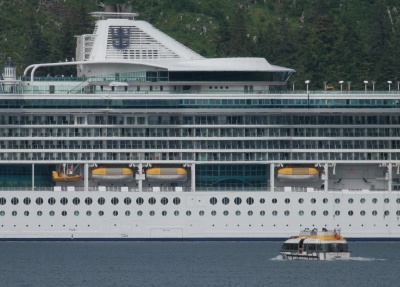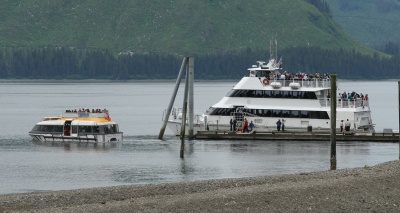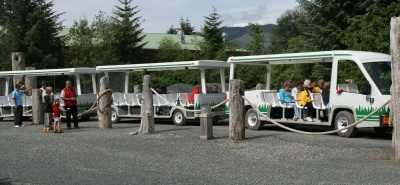

 Share This Page
Share This Page| Home | | Sailing | | Alaska 2006 | |  |  |  Share This Page Share This Page |

Copyright © 2006, P. Lutus. All rights reserved.
(double-click any word to see its definition)



My readers may be aware that 2/3 of Americans are either overweight or obese1. The most charitable people explain this as resulting from unfortunate but unavoidable genetic influences, or, as I first heard it expressed as a child, "glands" (as in, sotto voce, "It's because of her glands."). The less charitable among us say we eat too much and don't exercise enough, and these torpid habits are killing us. This viewpoint is on the verge of being declared Politically Incorrect, because it suggests we are responsible for our own circumstances and condition, a spectacularly unpopular idea at a time when nearly everyone thinks of himself as an innocent victim of something or other. "God made me this way, you have to accept it, and where did you put the Twinkies?" When I first put up my BMI calculator page, I got a bunch of e-mails from people accusing me of "blaming the victim," unfairly singling out those unfortunates whose refrigerator doors don't have padlocks, people who are powerless to guide themselves past the nearest buffet table. All P.C. posturing aside, we should think of ourselves as machines that take in fuel and put out work. If we only put out work and don't take in fuel, we die. Similarly, if we only take in fuel and don't put out work, we die. But it's easy to distinguish those who put out too much work and those who take in too much fuel — the latter are fat, sometimes spectacularly fat. All of us have heard from people who say they cannot lose weight, no matter what they do. Research reveals these people haven't tried anything besides rationalizing, and rationalizing just doesn't burn enough calories. I have a BMI of 27, so I am officially overweight. I deal with this by doing all I can to get exercise, to make up for all those burritos, cheese sandwiches and assorted truck I take in. One of my favorite ways to get exercise is to hike around in Alaska, where there is likely to be something beautiful to see, something that more than pays off the effort of the hike (the trick to getting exercise is to choose something that is its own reward).Access to the Woods
It is much easier to find a good hiking trail in Alaska than in the lower 48. One of my pet gripes about the accepted rules in American society is that more and more nice tracts of public land become inaccessible as time passes. I can't tell you how many times I have come to depend on a particular area being available for walking, only to see access to it taken away by the opening of a new suburban development. It is as though the point of urban/suburban/exurban planning is to seal land off from hikers. I should point out that this U.S. practice is not typical of western countries. In Germany, to name just one example, land owners are required to allow passage of hikers if their land blocks access to public land. This is not the rule in the U.S., in fact, it is nearly unheard of — once all the tracts of land along a roadway go into private hands, the public land behind the tracts becomes inaccessible (except to those who own the tracts). In Alaska, at the time of writing, there are still adequate hiking opportunities, simply because there is so little privately held land. But this summer I saw the complete removal of a trail I had enjoyed in past years, so even in Alaska the lower 48 rules sometimes apply.Paving the Trails
Hoonah is a town along Icy Strait, west of Juneau. It has — or, should I say, had — a nice trail leading to a point that looks out across Icy Strait. I've been enjoying this trail for years, but a recent sequence of events has quite literally wiped this trail off the face of the Earth. The first change is that the big tour boats have started coming to Hoonah (see pictures on this page). These tour boats, essentially floating hotels with thousands of guests, often totally change the towns they visit because of their economic impact. Some Alaska towns, which had almost become ghost towns after the collapse of commercial fishing, have been brought back from the dead by tour boats and tourism. There is something you need to understand about tour boat clients — some will do anything to avoid exercise. They expect to be transported everywhere, and if they find themselves walking, they will openly wonder why they paid thousands of dollars only to have to walk somewhere. As a result, tour boat operators recently petitioned the Anchorage city council to allow Segways (sophisticated, battery-operated personal transporters) on city streets, so tour boat clients could take a walk in a historic district ... but without actually walking. Given this trend, and with regard to Hoonah's pretty nature trail, the tour boat operators figured out how to get their clients out on the trail — they would replace the trail with a gravel road, and run a sort of miniature railroad train (see picture this page) along the road, filled with sedentary tourists. Of course, this meant no one could walk along the trail/road any more, for perfectly reasonable safety concerns. Someone might object that many of these tourists are elderly and not able to hike any more. In my view, those people should take shorter hikes, but people shouldn't expect to do without exercise, at any age — such a decision would shorten their lives. Also, many of the tourists who get on this silly little train are either too young or too fat to have an excuse for being driven along a perfectly good nature trail. In fact, the original route for the train went up a hill for a nice view, but the operators quickly discovered the tourists were too fat and the train couldn't climb the grade, so that part of the tour was abandoned. Obviously the tourists could get off the train and walk up the hill, but ... have you been paying attention? So, the Hoonah trail is gone, due to forces in U.S. society that, in the face of an obesity epidemic, work to eliminate recreational opportunities and encourage people to avoid exercise. I was actually planning to write more on this topic, but instead, I think I'll go hiking. See you on the trail.Body Mass Index
Oveweight Defined as having a BMI of 25 to 29.9 Obese Defined as having a BMI of 30 or greater BMI Body Mass Index, equal to W/H2, W = weight in kilos, H = height in meters
| Home | | Sailing | | Alaska 2006 | |  |  |  Share This Page Share This Page |